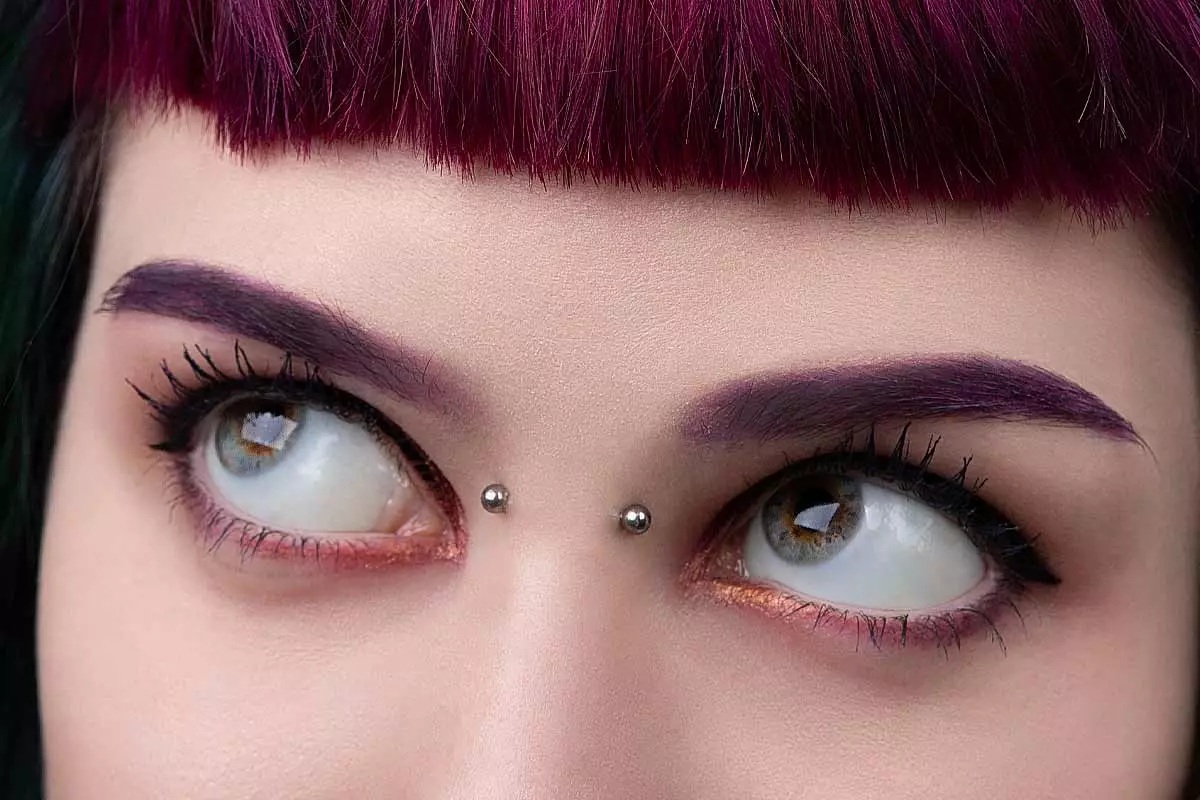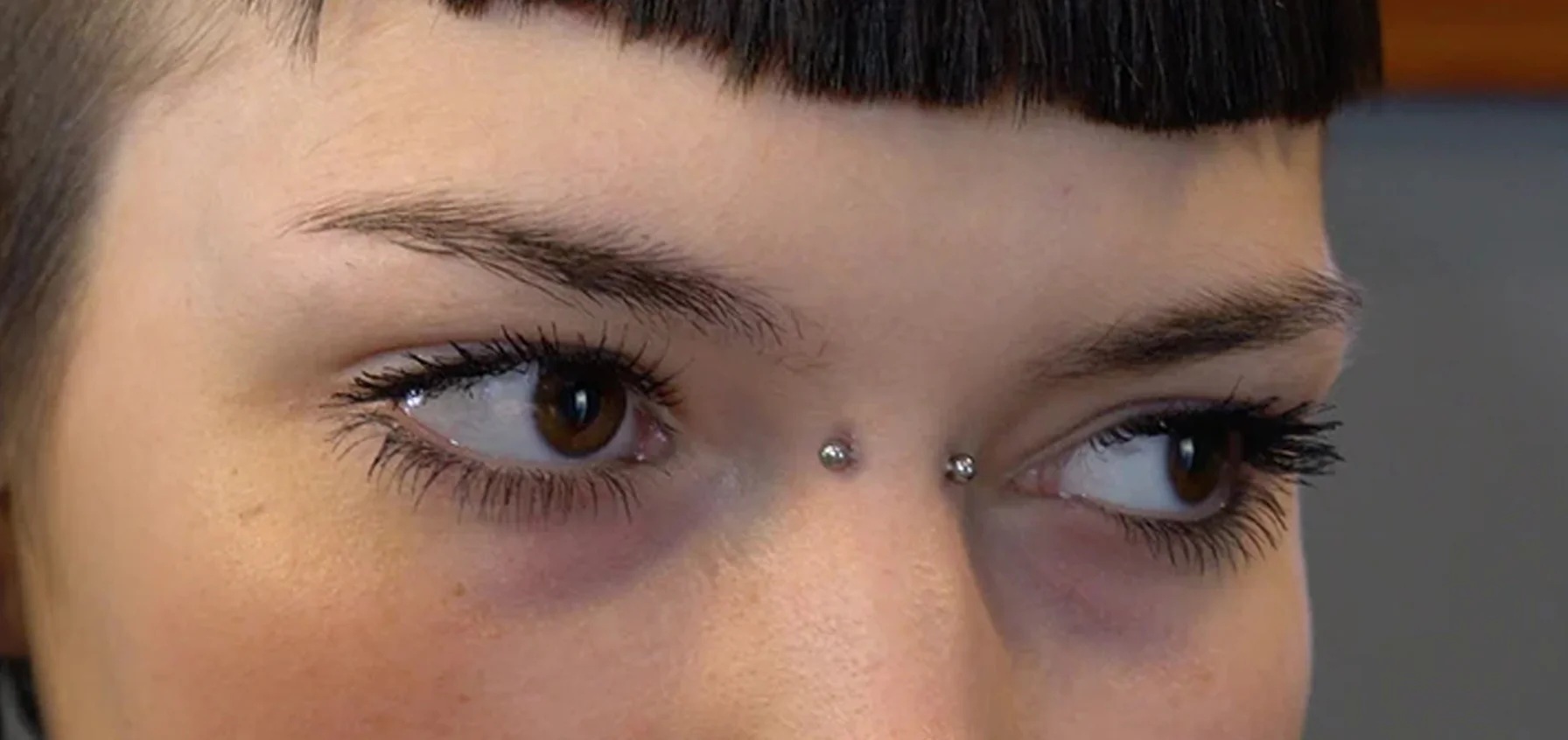Bold, symmetrical, and undeniably eye-catching, the bridge piercing is a statement of confidence. Placed horizontally across the bridge of the nose, between the eyes, it creates a striking focal point that beautifully accentuates the wearer’s facial structure. It’s a piercing that eschews subtlety for a powerful, modern aesthetic, demanding attention and admiration.
However, the visual impact of a perfect bridge piercing is matched only by the technical skill and anatomical knowledge required to perform it safely. This is not a standard piercing; it is a complex surface piercing in a highly visible and mobile area of the face. Its success is less about desire and more about a perfect match between your unique anatomy and the piercer’s expertise. At PinkTatPier, we treat this piercing with the profound respect it deserves.
We recently had a consultation with a client, Marcus, who was interested in a bridge piercing London. He had visited another studio where the piercer had glanced at him and said, “Yeah, no problem.” Feeling uneasy about the lack of a thorough assessment, he came to us for a second opinion. Our lead specialist spent the first ten minutes of the consultation not with a needle, but with their hands and eyes. We performed a detailed “pinch test,” gently assessing the tissue on his nasal bridge. We explained that while he had some pliable tissue, it was on the minimal side, and we openly discussed the increased risk of migration and the importance of perfect aftercare for his specific anatomy. Marcus was so impressed by the honesty, the detailed explanation, and our willingness to prioritise his long-term success over a quick procedure that he chose to proceed with us, fully informed and confident that he was in the safest possible hands.
This story is the core of our philosophy. This guide is an extension of that honest, expert consultation, designed to provide you with all the information you need to understand the bridge piercing London, its challenges, and why choosing the best piercing specialist is the most critical decision you will make.

bridge piercing
Deconstructing the Bridge Piercing: More Than Skin Deep
To understand why this piercing requires such expertise, it’s essential to understand what it is and where it is placed.
The Correct Placement: The “Pinchable” Tissue
A bridge piercing is a horizontal surface piercing. It is performed using a straight barbell that passes through the loose fold of skin and flesh at the very top of the nose, right between the eyes.
A crucial and often misunderstood fact is that the piercing does not go through bone or the thick nasal cartilage. It sits exclusively in the soft, “pinchable” tissue above the nasal bone. If a piercer attempts to pierce through the bone or the hard cartilage below, it is a sign of profound inexperience and is incredibly dangerous.
Why It’s Considered an Advanced Piercing
The bridge piercing presents a unique set of challenges that place it firmly in the “advanced” category:
- It’s a Surface Piercing: Unlike a lobe or nostril piercing that goes through a distinct piece of tissue, a bridge piercing sits under a flat plane of skin. This makes it more susceptible to tension and movement, increasing the risk of rejection.
- High Mobility Zone: The area between our eyes is incredibly mobile. We frown, squint, and make countless expressions that move the very tissue the piercing sits in, creating constant micro-traumas during the healing phase.
- High Visibility: Its prominent placement means that any issue—be it crooked placement, irritation, or scarring from rejection—is immediately visible. There is simply no margin for error.
The Deciding Factor: A Deep Dive into Anatomy
We cannot state this strongly enough: anatomy is everything for a successful bridge piercing. Not every person is a suitable candidate, and a significant part of our professional responsibility is making this crucial assessment.

bridge piercing
The “Pinch Test”: Our Non-Negotiable Assessment
Before we ever consider marking or piercing, our specialists will perform a thorough “pinch test.” This is the single most important step in the consultation process.
Your piercer will gently but firmly pinch the tissue at the bridge of your nose. They are not checking for pain; they are assessing several key factors:
- Quantity of Tissue: Is there enough loose, pliable skin to create a deep and stable channel for the jewellery?
- Tissue Density: Is the tissue soft and fleshy, or is it very thin and tight against the underlying bone?
- Pliability: How easily does the tissue move? Too much or too little can present challenges.
A sufficient amount of pinchable tissue is essential to hold the piercing securely and minimise the risk of rejection. If the tissue is too tight, the jewellery will be under constant pressure, and the body will almost certainly push it out over time.
Factors That Can Disqualify You
Part of being the best piercing specialist is knowing when not to pierce. We will honestly advise against a bridge piercing if you have:
- Insufficient Loose Tissue: This is the most common reason. We will not perform a piercing that is likely to reject.
- Interference from Glasses: If your glasses sit heavily and directly on the area where the piercing would need to go, the constant pressure will make healing impossible.
- Previous Trauma or Scar Tissue: Significant scar tissue in the area can complicate healing and affect the final placement.
Our Studio’s Philosophy on Advanced Piercings:
“With a bridge piercing London, the most important and ethical thing a piercer can do is say ‘no’ when the anatomy isn’t right. Our role isn’t just to decorate the body, but to be stewards of its long-term health. We can create beautiful art with piercings, but we cannot create tissue where it doesn’t exist. A successful, lasting bridge piercing is a gift of anatomy, guided by a specialist’s steady and experienced hand.” – The Lead Specialist at PinkTatPier
The Piercing Procedure and Healing Journey
If you are a suitable candidate, the procedure will be performed with meticulous care, leading into a healing journey that requires diligence and patience.
Technique and Jewellery: Precision is Paramount
The bridge piercing is almost always performed freehand (without clamps) to allow the piercer to feel the tissue and create a perfectly level, symmetrical channel. A straight barbell made from implant-grade titanium is the only appropriate jewellery for an initial bridge piercing. Using a curved barbell is incorrect and will lead to almost certain rejection.
The Healing Timeline & What to Watch For
The healing process for a bridge piercing can be challenging and requires close monitoring. The table below outlines what you can expect and the critical warning signs to look out for.
Table: The Bridge Piercing Healing Timeline & What to Watch For
| Timescale | What to Expect | Key Aftercare & Warning Signs |
| Week 1-4 | Swelling is normal. Significant bruising is very common and can sometimes result in the appearance of two “black eyes.” The area will be tender. | Clean GENTLY twice daily with sterile saline; DO NOT touch or move the jewellery. Avoid wearing glasses if they put any pressure on the area. |
| Week 4-8 | The initial swelling and bruising should subside completely. The piercing will still be very delicate and not yet healed. | Continue cleaning; be hyper-aware of snagging on clothing or towels. Early Warning Signs: Start monitoring the piercing. Does it look like it’s getting shallower? Is more of the barbell becoming visible? |
| Month 2-4 | The piercing will start to feel more stable, but the internal channel is still very fragile. | It is critical to book a check-up appointment. Downsizing the initial longer barbell to a shorter one is essential once all swelling is gone to prevent snagging. |
| Month 4-6+ | The piercing may be fully healed, but surface piercings can remain temperamental. | Clear Signs of Rejection: If more of the barbell has become visible over time, if the skin over the bar is red, thin, or flaky, or if the piercing holes appear to be stretching or enlarging, contact us immediately. Early removal is key to minimising scarring. |
Contacting the Best Piercing Specialist in London

bridge piercing
Due to the critical importance of the anatomical assessment, our booking process for a bridge piercing is designed to prioritise your safety.
Why a Consultation is Mandatory
We require a mandatory, in-person consultation before we will book the piercing procedure itself. This is a complimentary service that allows our specialists to perform the essential “pinch test” and confirm that you are a suitable candidate. This professional-first approach protects you and upholds our unwavering standards of safety.
What to Expect and How to Book
Your journey to a stunning bridge piercing London begins when you contact us to book your initial consultation. During this session, we will perform the assessment, answer all your questions, and if you are a suitable candidate, provide you with a precise price quote for the procedure.
Frequently Asked Questions (FAQ)
1. Will a bridge piercing make me go cross-eyed or affect my vision?
No, the piercing will not damage your eyes or affect your vision. However, for the first few days or weeks, you will be very aware of the jewellery in your peripheral vision. Your brain quickly learns to tune this out, and soon you won’t notice it at all.
2. What happens if my bridge piercing starts to reject?
At the very first sign of rejection, it is crucial to have the jewellery removed by a professional. We will remove it for you. This allows the tissue to heal with minimal scarring. Leaving the jewellery in until it fully rejects will result in a more prominent scar.
3. Can I wear glasses with a bridge piercing?
This is highly dependent on your anatomy and the style of your glasses. During your consultation, we will ask you to bring your glasses so we can assess where they sit. If they rest directly on the piercing area, the piercing is not recommended. Sometimes, a slightly higher or lower placement is possible to avoid them.
Conclusion: A Piercing That Demands a Specialist
The bridge piercing is a powerful, high-impact style that makes a bold statement. Its success, however, is not a matter of chance. It is entirely dependent on the perfect intersection of two factors: having the right anatomy and choosing a true piercing specialist with the experience and integrity to execute it flawlessly. Don’t take a risk on such a prominent and delicate piercing.

bridge piercing
Your Next Step: Book Your Essential Consultation
Ready to find out if this striking piercing is right for you? Contact the best piercing specialists in London at PinkTatPier to book your essential, complimentary consultation today. Let our experts provide you with an honest assessment and a clear price for your procedure.
About the Expertise at PinkTatPier
PinkTatPier is more than just a studio; it is a collective of dedicated body art professionals. Our team possesses decades of combined experience and is committed to the highest standards of safety and artistry. We are passionate about ongoing education, regularly attending seminars on advanced techniques and aseptic protocols to ensure we are always at the forefront of the industry. Our core philosophy is “anatomy first,” ensuring that every piercing we perform is not only beautiful but perfectly suited to the individual, promoting a safe and successful healing experience for our valued clients in London and beyond.

